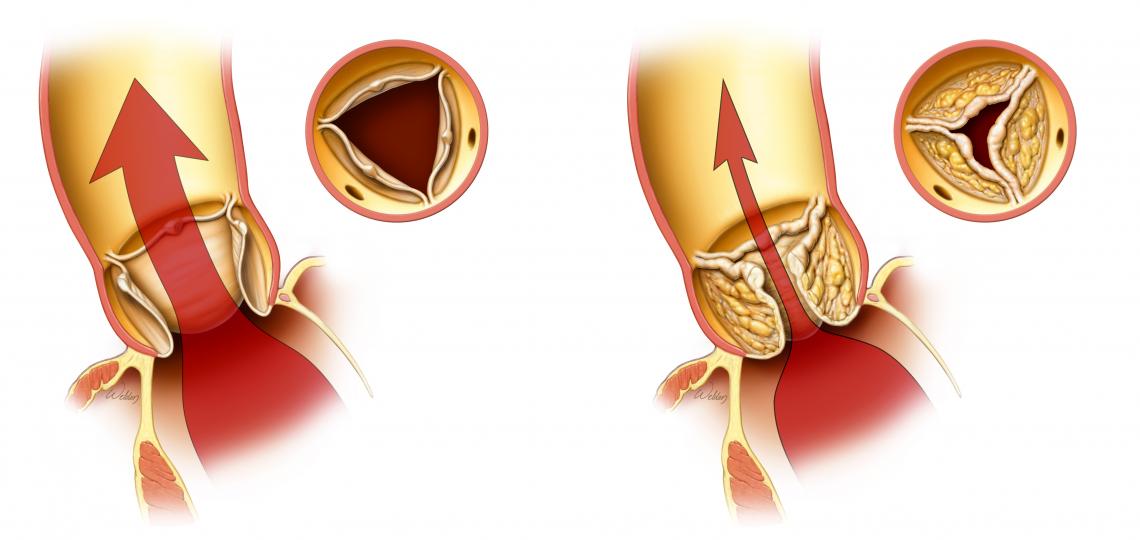The goal of heart valve surgery is to repair or replace a malfunctioning heart valve to prevent the development of life-threatening conditions.
Heart Valves
Valves are one-way gates in the heart that keep blood flowing between the four chambers of the heart. There are four valves in the heart and each one has strong flaps called “leaflets” that control blood flow.
Leaflets open to let blood move through the heart and out to the rest of the body. They then close to keep blood from leaking back in the wrong direction. The heart's chambers and valves all work together to keep blood flowing in one direction.
Stenosis
The heart valve can calcify and cause narrowing of the valve which is called stenosis.
Stenosis happens most often in the aortic valve, but can occur in any of the heart’s four valves. When a healthy aortic valve (illustrated) is open it's about as big as a half dollar, but sometimes a valve's opening becomes narrowed. In many cases, this is caused by the natural wear and tear of aging. As we get older, calcium can form on the valve’s leaflets. As this deposit builds up, the opening can become narrower and blood can’t flow as easily through the valve. When the stenosis becomes severe the valve must be replaced.
A normal open valve (left). A stenotic valve - partially blocked valve (right).
 Credit
Credit
If you've been told you have a tight valve, or stenosis, this American Heart Association video explains what it means and why it matters to your heart health.
 Credit
Credit
This American Heart Association video explains valve regurgitation, or a leaky heart valve.
Leakage
Valvular insufficiency or leakage happens more often in the mitral valve than in other heart valves. When a valve leaks, the leaflets don’t close completely and some blood leaks backward rather than all of it flowing completely in one direction. Like stenosis, valve leakage most often happens because the valve simply wears out as we get older, but other things like a defective valve at birth, or rheumatic fever, can also cause a leak. In some cases, these valves can be repaired. In many cases, they must be replaced.
A normal closed valve (left). A leaking valve - called insufficiency or regurgitation (right).
What Happens to the Heart With Stenosis or Leakage?
Both valve stenosis and leakage make the heart work harder. With stenosis, it has to work harder to pump blood through a narrowed valve. When the valve leaks, the heart has to strain so the body gets enough oxygen-rich blood. All of this extra work can make the wall of the heart thicken or it can cause enlargement of the heart’s chambers. This prevents the heart from working as it should and over time can lead to serious or even life-threatening problems.
Symptoms of Valvular Disease
You can have either valve stenosis or leakage and not know anything is wrong. However, if your condition becomes more severe you may begin to experience symptoms such as:
- Shortness of breath – especially when exercising
- Chest pain
- Lightheadedness
- Fainting
- Fatigue
- Heart murmur
Heart Valve Surgery
During this operation, the surgeon will make an incision, called a median sternotomy, in your chest and through the breastbone.
They will remove the defective valve and replace it with either a tissue valve or a mechanical valve, as was previously mentioned. During most open-heart surgeries, including valve surgery, it is necessary to connect you to a heart-lung bypass machine. During this time, your heart will stop. This machine takes over the work of the heart, oxygenating your blood and circulating it throughout the body. Your heart will begin beating again once the procedure is complete.
Recovery
It will take you approximately two months to recover from undergoing your valve surgery. You should plan to be away from work, getting your full strength back, for six to eight weeks. Your surgeon will advise you on post-operative restrictions and when it’s safe to drive again. Participating in a cardiac rehabilitation program will be beneficial in your recovery. Make sure to ask about this before you are discharged from the hospital and make arrangements close to your home in advance.










